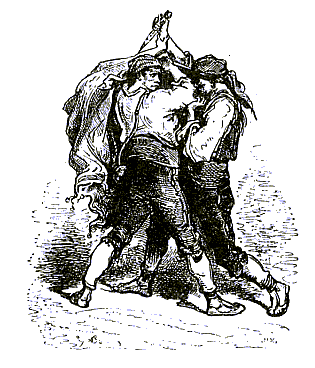
LESSON TEN
QUITES, HUIDAS
By now you should now have enough understanding of our lessons to know that the art of tirar ß la navaja is not founded solely upon the caprice of some prisoners or men of bad living, and that on the contrary, it is subject to rules and principles as exacting as those of fencing and the saber. When we come to speak on some of the tretas that are used in the wielding of the navaja, we will give reason to the more enraged detractors of this arm, in regard to those, by their being in the major part born of inadequate education and the most ignoble sentiments; but until then, and doing without the facts which reprobate those men who themselves have something, being of a class that wants, we will maintain that the art of tirar a la navaja deserves to be considered in the same way as the art of all other arms.
We have already explained the methods of attack, and the various types of golpes more worthy of attention, we go now to give the explination of the quites that are in practice for defence; a very essential part in the wielding of all edged weapons, since without it your destreza is unreliable and of no value regardless of whatever is said relative to the manner of offence.
It is believed by many that the most secure method of tirar a la navaja consists in having the body continualy in motion, implying that the diestro should always be jumping and circling the adversary. And surely nothing has less appearance of truth; the diestro fights with much calm and serenity, and although he can jump great distances and fight with prodigious agility, he is sure and very opportune in his executions on these given occasions, his movements at times not leaving a circle of three feet.
The serenity makes the diestro oportune in his movements, and this is only aquired with much practice; in such way, that accustoms the vision to measuring distance, and awaiting with tranquility and without fear of the golpe which the adversary strikes, when he knows that it will fall short of reaching the body by an inch or even half an inch.
If the golpe enters only a little into the terreno of the diestro, he can defend against it by withdrawing the part of the body that is threatened, and without needing to flee or jump. But if the exact nature of the action of the adversary is unknown to the diestro because of its great velocity, or the glope that has been struck will enter into the center of the terreno, he evades with the huida jumping backwards or to the side, to a distance appropriate to avoid being reached, and if possible, for reaching the attacker; taking great care to not trip over his feet, and resting upon the balls of the feet, with the object of not being taken off guard and being ready to quickly make two, three, four or more such jumps.

This manner of quitar is the most frequent; but there is another that is more risky, although secure, if the timing is correct, and it consists in setting aside with your unarmed hand the armed hand of the adversary when he reaches to strike. In the floretazos this quite may be executed with great success, sometimes being able to seize the wrist of the adversary; for that reason we warned that those golpes must be struck very rapidly and in a disposition to cut the hand or arm that goes to quitar, using in effect one quarter a plumada.
Fighting with the hat in unarmed hand, quites may be made with it, with the intention to disarm by giving a strong shock to the hand of the attacker.
Also be made with frequency is one way of quite, which is the most risky of all, and is of the following method. When the armed hand of the enemy approaches the terreno of the diestro for the parte baja, this may be defended against by striking out with a strong kick to the fingers that hold the navaja, which causes the adversary to release his grip leaving him unarmed. We have already said that it is risky, and so is the truth; since if the diestro fails to strike the target with his foot, surely he will be wounded by his opponent in a most terrible manner, from which only one thing may save him, throwing himself to the ground and at the same time giving a kick to the lower belly of his adversary.